Green Transition in a Dynamic Clean Tech Region
Summary: Styria ranks among the strongest R&I locations in Europe. Its Economic Strategy 2030 has a clear focus on cluster support and development. The region’s business development agency SFG promotes six industry clusters, which are thematically aligned with the economic strategy. The Graz-based Green Tech Valley cluster is located in the fast-growing clean tech market, which is expected to triple by 2030 to around €600 billion annually worldwide. Since its founding in 2005, the cluster has developed into one of the leading clean tech clusters in Europe. With innovative approaches such as the Green Tech Radar and Green Transformation Cards, or activities such as the co-initiation of a hydrogen research centre, the cluster significantly contributes to the region’s green industrial transition.
The Styria region
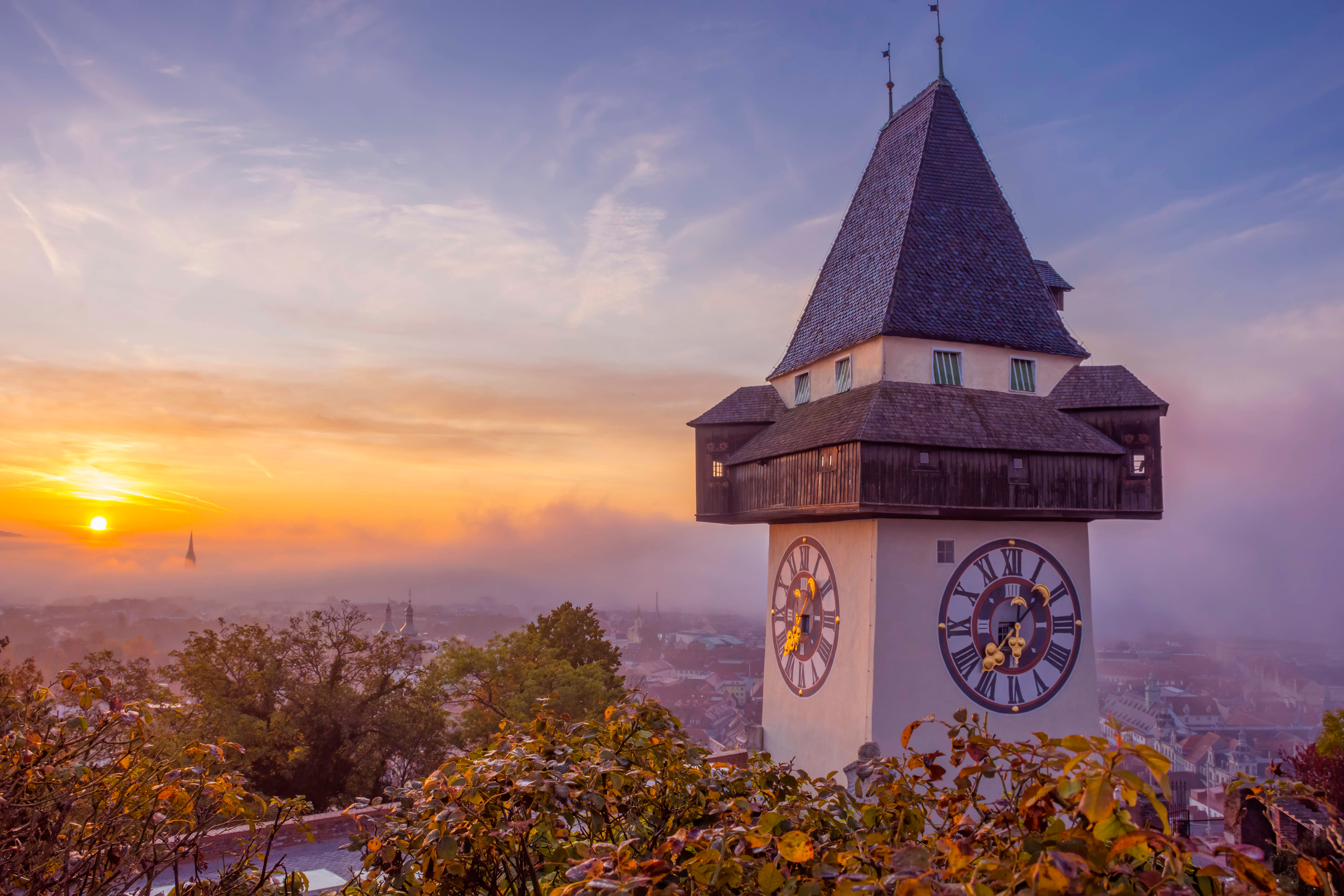
The Styria region is located in the south-eastern part of Austria. With an area of approximately 16,400 square kilometres, it is the second largest federal state, after Lower Austria. In the south, Styria is bordered by Slovenia. All other borders are covered by the Austrian federal states Carinthia, Salzburg, Upper Austria, Lower Austria, and Burgenland. Styria is home to approximately 1.27 million people, spread over a total of 13 districts. Approximately 77,000 companies contribute to the Styria business location and almost 7,350 of which export their products and services around the globe. This makes Styria the third-largest exporting state in the country with exports in the value of €28.9 billion (14.9 percent of Austria's total exports). In terms of R&D activities, the region serves as a national hub for education and knowledge. Around half of all Austrian research centres are located in Styria, next to nine universities and universities of applied sciences. With a R&D quote of 5.17 percent Styria is among the top three Research and Innovation (R&I) locations in Europe.
Styria’s economic fabric is determined by a strong industrial heritage. Traditionally, manufacturing, construction, agri-food, mobility-transport-automotive, and energy intensive industries are of high importance for the region’s economic development. In 2022, the region’s total GDP reached approximately €56.2 billion. However, almost half of the region’s GDP is generated in Graz, the region's capital, which is known as a college and university city and home to nearly 340,000 inhabitants.
The EU Regional Innovation Scoreboard (RIS) for Austria covers only the three NUTS 1-level states East-, Southern- and West-Austria. Styria and neighbouring Carinthia form the “Southern Austria” region, which is classified as a "strong innovator". In the field of eco-innovation Austria – and Styria in particular – is an “Eco-Innovation Leader”. As Styria is the dominant economic area in the “Southern Austria” region and accounts for more than two-thirds of the region’s population and almost 70 percent of its economic output, the RIS ranking confirms Styria’s leading position regarding the country’s innovation performance. Although stagnating for some time, the region improved its innovation performance slightly in recent years (+2.8 percent between 2016 and 2023). Since then, regional authorities maintained a strategic focus on industrial transition in order to maintain Styria’s high level of innovation.
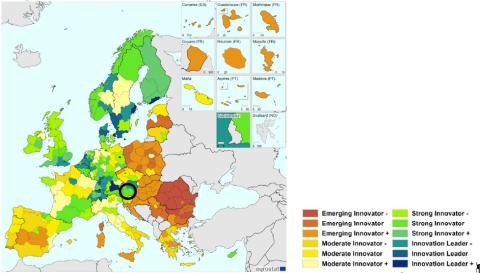
Regional Innovation Scoreboard 2023. Source: European Commission
Styria features a strong economy with both traditional industries and new future technologies. In addition to being a strong R&I location, the region constitutes an economic centre with particularly innovative sectors, such as mechanical engineering, mobility and construction. In addition, electronics, digital and, above all, the clean technology sectors established themselves as central pillars of the region’s economic fabric in recent years. New cross-sectoral topics such as in mobility, green tech and digitalisation/AI are opening up new opportunities for the region to exploit its strengths in topics such as "clean mobility" and "green technologies". All of these challenges and opportunities are incorporated in the Economic Strategy Styria 2030.
The region’s strategy document outlines Styria’s comprehensive approach to fostering economic development and innovation. It serves as a blueprint for Styria's economic policy and entails a clear focus on clusters. It also functions as the region's Smart Specialisation Strategy (S3). The strategy focuses on various elements, which underline a cross-sectoral approach: cross-industry and cluster support, cross-clustering, innovation and project development, collaboration and cooperation, the integration of Scientific and Business Research and last but not least the technological focus on mobility and automotive technologies, advanced manufacturing and Industry 4.0, green technologies and sustainability, ICT, life sciences and biotechnology, materials science and nanotechnology, and creative industries and digital media.
The strategy focusses on five core objectives:
- Location development and location management: Orientation towards the guiding markets of mobility, green tech and health tech as well as technological core competences are to be further implemented with vigour.
- Innovation and R&D promotion: Integration of additional companies in the innovation process and expansion of the spectrum of innovative services. In addition, the range of innovative services is to be expanded and companies are to be supported in their transformation to a low-carbon economy.
- Entrepreneurship & growth of young companies: Increase foundation dynamics and growth capabilities for young companies. Ideal framework conditions are to be created that orientate themselves towards international standards.
- Qualification & human potential: The availability of qualified employees is decisive for the performance capability of the economy. Today, the demand for specialists already poses a challenge and will further intensify in the coming years due to demographic developments and social value changes. Strengthening human potential is therefore crucial.
- Internationalisation of companies and location: Internationalisation of the location on a large scale, which requires respective activities within the state for promoting export and the expansion of the worldwide network.
Overall, the Economic Strategy Styria 2030 aims to transform the region into an innovation leader, ensuring sustainable and inclusive economic development through strategic technological advancements and robust collaboration among industries and clusters.
While the strategic course for the innovative progress of the region is set at the state level, the SFG, (Styrian Business Promotion Agency) acts as an “extended arm” of the state government. It ensures that the region’s economic strategy is followed by “smart implementation” and it is in close contact with the regional clusters but also with the European Commission. Unlike many other regions of this size, Styria has a specially developed strategy for Europe and the international context.
The guiding themes of the Styrian Strategy for Europe are climate policy, digitalisation, strengthening Europe's role in the world and strengthening a democratic and transparent Europe. In addition to these guiding themes, the individual fields of action and specific measures are also largely derived from the self-image of the Europe and International Affairs Department of the Office of the Styrian Provincial Government.
The fields of action of the Styrian European Strategy
- EU communication
- Representation of Styrian interests in Europe
- Establishing and maintaining international contacts
- Development co-operation
All in all, the topics that have been strategically formulated are relevant both for the region and for Europe; although their high "flight altitude” makes implementation on the ground challenging. However, both strategies form the basis for the orientation of all actions and measures that are set up both by the SFG and in the cluster policy context.
Further reading:
- Economic Strategy Styria 2025 – Growth Through Innovation: https://www.verwaltung.steiermark.at/cms/dokumente/12493649_75777498/2dcd8d7f/Wirtschaftsstrategie2025_EN.pdf
- Economic Strategy Styria 2030: https://www.wirtschaft.steiermark.at/cms/dokumente/12907475_174367847/3a8cdb3b/Wirtschaftsstrategie_Stmk_2030.pdf (in German)
- European Strategy for Styria: https://www.europa.steiermark.at/cms/dokumente/12831289_2950520/f068788e/Strategie_des_Landes_Steiermark_Europa_und_Internationales_2021neu.pdf (in German)
The Styrian Economic Strategy 2030 aligns with several industrial ecosystems defined by the European Commission. The key ecosystems addressed in the strategy include:
Mobility-Transport-Automotive: Styria has a strong focus on the automotive and mobility sector, particularly through the ACstyria mobility cluster, which promotes advancements in electric mobility, autonomous driving, and smart transportation systems.
Digital: The strategy emphasises the development and application of digital technologies, including artificial intelligence (AI), big data analytics, cybersecurity, and the Internet of Things (IoT), fostering innovation across various sectors.
Renewable Energy: Styria’s strategy highlights the importance of green technologies and sustainability, promoting renewable energy solutions, energy efficiency, and sustainable manufacturing practices.
Health: The region has a strong emphasis on life sciences and biotechnology, aiming to leverage advancements in medical technology, pharmaceuticals, and bioengineering.
Creative & Cultural Industries: The strategy includes support for creative industries and digital media, recognising their growing importance and the role of technological innovation in these sectors.
Electronics: Styria focuses on materials science and nanotechnology, relevant to the electronics industry by developing new materials for use in various high-tech applications.
By addressing these ecosystems, the Styrian Economic Strategy 2030 aligns with the European Commission’s vision for industrial transition, aiming to enhance the region’s innovation capacity, economic resilience, and sustainability.
The region of Styria started its cluster activities in the 1990s with a pioneering project that led to the establishment of the country’s very first cluster ACstyria in 1996. Not only has Styria’s cluster policy been one of the catalysts in the region’s transition away from its former reliance on heavy industry, it also triggered the development of an innovative cluster landscape throughout Austria, with today’s relevant trends, technologies and regional issues.
The Styrian cluster ecosystem counts ten regional clusters. Styria’s Business Promotion Agency SFG manages the interests and funding opportunities of the below-listed six cluster organisations, which are organised as limited liability companies (GmbH). SFG is involved as a public shareholder in these clusters.
Clusters supported by SFG:
- ACstyria – mobility cluster
- Green Tech Valley Cluster – climate protection and circular economy
- Human.Technology Styria – life science and health technology
- Holzcluster Styria – wood and forest-based industry
- Creative Industries Styria – creative industries
- Silicon Alps Cluster – technology and innovation cluster for electronic based systems
The six clusters draw from three different funding sources: One third of the financing stems from basic SFG funding, another third from member contributions and the final third from project funding. Taken all together, the six SFG clusters are privately financed by two thirds. The remaining four clusters in Styria Austrian Centre of Industrial Biotechnology (acib), Cluster for Automation & Advanced Technologies Styria, BioNanoNet Forschungsgesellschaft mbH (BNN) and Photonics Austria receive no public basic funding via the SFG.
Although the institutional setup might imply a structural dependence on the SFG, each cluster operates autonomously in their specialised subject areas and maintains a high level of independence in terms of strategic directions and networking. In fact, as cross-sectoral and transformative topics are becoming increasingly important, Styria’s clusters successfully strengthened their collaboration in the recent past by exchanging ideas, connecting members from different industries and creating new approaches to tackle the digital, social and green transformation. This “culture of cooperation” as a basis for the work of clusters in the region is enshrined in the Styria’s Economic Strategy 2030.
As the efficient and sustainable use of natural resources is becoming increasingly important, clean technologies play a key role in the green transition and tackling climate change and biodiversity loss. The transition of industry to low-CO2/free production and clean technologies for energy transition and circular economy are an essential condition for a successful implementation of Europe’s Green Deal. In its recent Report on EU policy initiatives for the promotion of investments in clean technologies, the European Commission estimates that the global market for clean tech equipment is set to triple by 2030 to around €600 billion annually.
Austria’s clean tech sector is characterised by strong growth and high employment. In 2020, over 2,700 companies in the Austrian environmental technology sector from industry and services created around 51,500 jobs and generated around €15.24 billion in sales revenue (2019 data basis), which corresponds to annual growth of 6.0 percent since 2015. The clean technology industry accounts for around €11.94 billion in sales and more than 37,800 jobs. The number of jobs in the manufacturing sector alone has increased almost 3.5-fold in the last 26 years and turnover has increased almost 8-fold.
Young entrepreneurs have also recognised the huge potential of the clean tech sector. Since the beginning of 2024, 193 clean tech start-ups have been listed in Austria, offering solutions for climate protection and the circular economy. This represents an increase of 15 percent compared to the previous year. Styria ranks first with around a third of the total start-ups, overtaking Vienna for the very first time. In general, Styria has a competitive edge in the relevant technology fields of the "clean tech industries" (e.g. intelligent energy, building and environmental technology, circular economy and recycling), in particular, due to the region’s successful collaboration with its renowned Green Tech Valley Cluster.
Green Tech Valley Cluster

The Graz-based Green Tech Valley Cluster is a major hub for cutting-edge climate and circular solutions. Founded in 2005, the cluster gathers more than 300 cluster members with a Green Tech turnover of €7.6 billion (in 2022) from different areas of the energy and environmental technologies, making it one of the world’s densest clean tech communities. In view of Styria's strategic orientation, the cluster plays a central role in promoting sustainable innovations. In particular, because the key initiatives of the Green Tech Valley Cluster include substantial advancements in hydrogen research and numerous R&I projects. In 2023, the cluster saw a significant increase in innovation activities, with eight new Competence Centers for Research and 40 innovation projects launched. These efforts have led to a 50 percent boost in hydrogen research and the establishment of new research infrastructures.
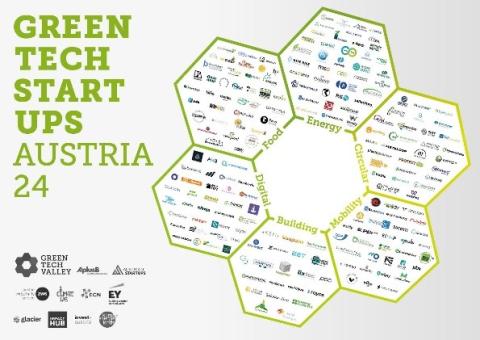
Source: Green Tech Valley Cluster
For start-ups, the cluster offers extensive support, including networking opportunities, access to industry and innovation hubs like the Green Tech Hub in Graz. This hub provides office space and development support for young companies, fostering an environment where new green technologies can thrive.
Green Tech Valley is also closely integrated into the circular economy network at the European level. As a member of the International Cleantech Network, it is not only connected to 22 of the world's leading cleantech clusters, but also offers its members access to around 4,000 foreign companies. In addition, the cluster management has twice received the GOLD label for excellence of the European Cluster Excellence Initiative (ECEI) and is ranked first in the Global Cleantech 100 by the US Cleantech Group.
The Green Tech Valley Cluster is organised as a limited liability company (GmbH) and governed by a public-private partnership, consisting – on the public side – of the Styrian Business Development Agency SFG, the Regional Government of Styria, the City of Graz, the Regional Government of Carinthia, the Ministry of Climate Action and Energy and – on the private side – of four private companies. In 2023, the cluster opened a management office in the Carinthia region, in 2024 the region of Burgenland officially became part of the cluster, thus representing a successful example of a cross-regional (meta) cluster.
The overall objective of the cluster is to be a global technology hotspot for climate and circular solutions and thus to drive forward the dynamic development of the regional innovation ecosystem. This is defined in the cluster’s vision in the Cluster Strategy 2020 – 2025 framework from 2020. The vision requires new strategic steps, as the industry has changed rapidly in recent years and has evolved from a niche to a mature ecosystem. For this reason, cutting-edge research should be promoted, the focus should be on innovative solutions and Green Tech Valley should be established internationally. The cluster management sees itself not only as a classic networker, but also as a trend scout and innovation driver.
The following topics and technologies are of strategic relevance until 2025 and are to be strengthened and / or developed:
Climate Solutions
- Green gas and hydrogen
- Climate-neutral company
- Integrated heat transition
- Carbon capture and utilisation
Circular Solutions
- Circular future – digital value chain
- Next sorting technology
- Battery re-use, recycling and safety
Expanding Ecosystems
- Expanding cooperation between research and companies
- Docking companies with international companies and clusters
- Identifying companies in fields of action throughout Austria and strengthen the federal-state axis
Supplement Services
- Expanding matching and mutual learning
- Expanding clean tech radars and communicate the green tech valley
Strengthen Growth
- Screening market needs and scale solutions and market them in a targeted manner
The Green Tech Valley Cluster offers a comprehensive service portfolio aimed at fostering innovation and growth in the clean technology sector. It is dedicated to advancing clean technologies through a blend of support services, networking opportunities, and promotional activities, driving innovation in climate protection and the circular economy.
Green Tech Valley Action Plan 2024 (in German)
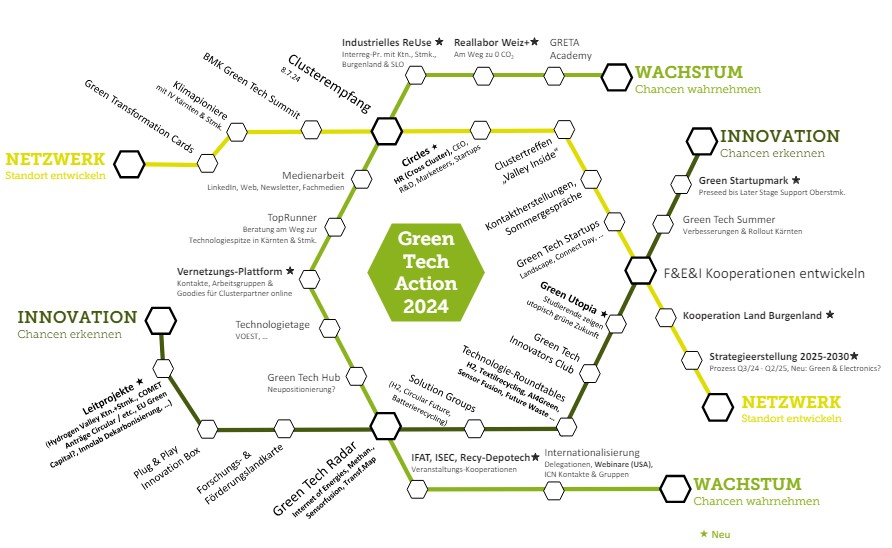
Source: Green Tech Valley Cluster Annual Report 2023
Innovation and R&I Support:
Technology Trends and Market Opportunities: Green Tech Valley provide insights into upcoming technology trends and market demands through the Green Tech Radars. The tool helps companies to identify future opportunities and stay competitive.
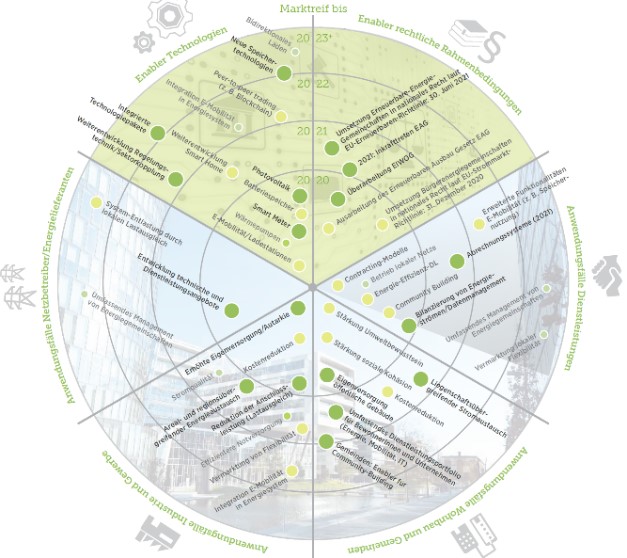
Green Tech Radar “Energy communities”
- R&I Project Initiation: The cluster facilitates the initiation and management of research, development, and innovation (R&D&I) projects. In recent years, they have supported 40 innovation and business projects with significant collaborative value.
- Workshops and Webinars: Companies can gain new input and ideas through webinars and tailored workshops (i. e. Green Tech Innovators Club, R&D Circle, Technology Roundtable).
Networking and Collaboration:
- Matchmaking and Knowledge Transfer: The cluster connects businesses, start-ups, and research institutions, providing access to a network of over 800 businesses and export contacts. This is crucial for developing green innovations.
- Media Collaborations: They help raise the visibility of innovations through media collaborations, newsletters, and social media platforms.
- Participation in Events: The cluster supports participation in industry-relevant events and trade fairs, providing opportunities for companies to showcase their innovations and connect with potential partners and investors.
Start-up Support:
- Clean Tech Start-ups Platform: This platform highlights innovative start-ups in the clean tech sector, providing visibility and networking opportunities.
- Office Spaces and Networking Services: The Green Tech Hub offers subsidised office spaces and networking services to start-ups, facilitating the development of their business ideas.
Consulting and Business Development:
- Subsidy and Funding Assistance: The cluster offers guidance on available subsidies and funding tracks, assisting companies in securing financial support for their projects.
- Business Development Workshops: They offer individual company workshops focusing on strategies to increase sales and to become a climate-neutral company (Green Transformation Map).
Visibility and Promotion:
- Green Tech Valley Solutions Platform: This platform allows companies to display and promote their solutions, enhancing their visibility on national and international stages.
- LinkedIn and Media Presence: Companies can raise their profiles through active promotion on LinkedIn and other media channels facilitated by the cluster, with close to 10,000 followers.
Further reading:
- Green Tech Radar: https://www.greentech.at/green-tech-radar/ (In German)
- Green Transformation Map: https://www.greentech.at/tools/green-transformation-map/ (In German)
When the first so-called 'hydrogen hype' emerged in Europe in 2019 and market participants realised the concrete market opportunities of green hydrogen for industry, energy systems and, in some cases, mobility, the Green Tech Valley re-shifted its strategic focus towards green hydrogen technologies and aimed at strengthening research, infrastructure and local jobs. Starting from a small number of companies and research institutions, with a focus on mobile applications, the cluster was able to initiate the launching of three regional R&I calls with a budget of €10 million. After highlighting the new technologies’ potential by applying its technology radar, through workshops or by creating a H2-Research Map, the cluster managed to co-initiate the Hydrogen Research Centre Austria in Graz with the aim of attracting new partners. The cluster also contributed in various ways to the centre’s outcome, such as a 50 percent increase in H2 researchers in the region within two years. Several hundred jobs have been and are created right now at the partner companies thanks to the cluster's contribution. For 2024, an EU Hydrogen Valley application with expected investments of several hundred million euros has been developed.
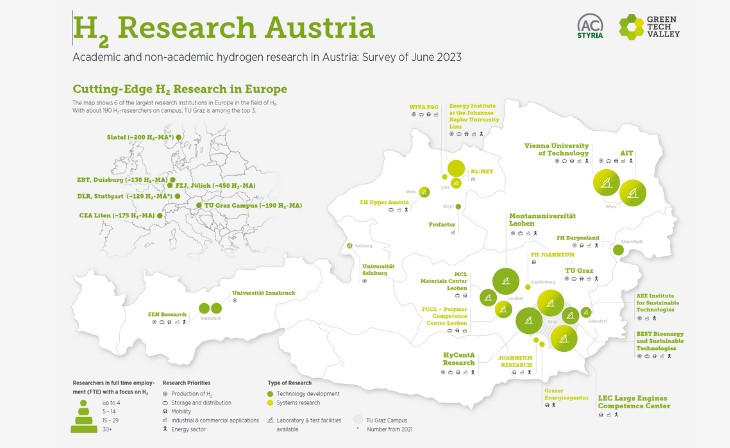
Source: Green Tech Valley Cluster
The Clean Tech Valley cluster has had a strong impact on the region's innovative capacity not only in the hydrogen industry, but also in the key area of recycling and waste management. Waste management and recycling have the lowest level of digitalisation of all sectors. At the same time, new EU recycling quotas can only be achieved if digitally enabled. The aim of the cluster was therefore to enable the concept ‘no material flow without data flow’. Leading companies and relevant partners should work together, research should be bundled and research infrastructures should be established. Through working groups, delegation trips and the opening of the Andritz Recycling Technology Centre at a Graz-based cluster partner, a joint venture was set up that developed the world first data standard for recycling MTP (Modular Type Packaging) that was presented to the world for the first time at the Expo in Dubai.
At the meta-level, the cluster can be considered a vocal representative of the strong clean tech location of Styria. Green Tech Valley strives for a central position and support for existing customers (clean tech companies) as well as potential new customers (i.e. companies from all sectors). Since 2020, the cluster has initiated measures such as the Green Transformation Cards, which support companies in implementing green measures. The innovative cards have already been successfully used by 5,000 companies in 20 countries. The GRETA Green Tech Academy Austria at the Graz Technical University and new MBA programmes are expanding training in the field of green transition, while so-called technology days between 180 major industrial sites as users and clean tech providers have promoted concrete technology implementation and led to more sales. Upon initiative of the cluster, a real-world laboratory for net-zero industry has been created and the NEFI+ innovation laboratory has been strengthened. Further impacts can be seen in investments in green steel and decarbonisation in the region, as well as the recognition of Graz as a finalist for the EU Green Capital 2023.
Further reading:
- H2-Research Map: https://www.greentech.at/en/tools/hydrogen-research-map-austria/
- Green Transformation Cards: https://www.greentech.at/en/tools/green-transformation-cards/
- MTP Recycling Standard: https://engineering-update.co.uk/2024/04/04/setting-the-standard-mtp-technology-and-its-impact-on-the-industry/
LESSONS LEARNED AND TRANSFERABILITY
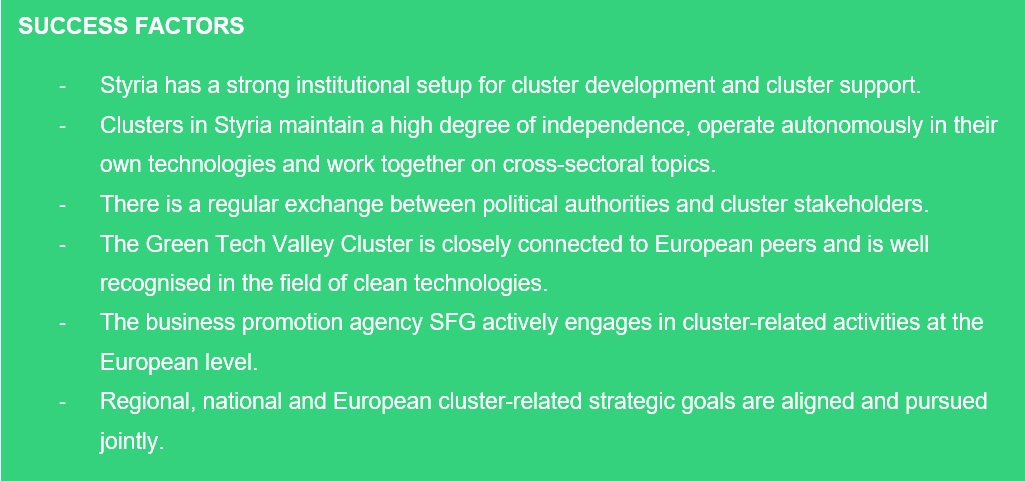
The region of Styria and the Green Tech Valley cluster are a prime excellent example of how clusters can closely work together with regional authorities and pursue common goals while at the same time maintaining a high level of strategic independence. Styria’s clusters pursue their own political or cluster strategic objectives. As the extended arm for implementing the region's economic strategy, both the SFG and its six regional clusters constitute a successful link between the political objectives and the strategic and entrepreneurial perspectives of the region’s companies.
Within a comparatively short period of time, the Green Tech Valley cluster helped transform the region into an internationally recognised top player in the clean tech sector. This translated in a positive economic impact on the location. The regional authorities, in turn, greatly appreciate the fact that the clusters provide a political ‘neutral ground’ on which cooperation and new ideas can be developed without external influences.
The case of Green Tech Valley Cluster and the Styrian region illustrates how clusters can facilitate the institutional and economic development of a region in a relatively young technology field, i.e. clean technologies. At the same time, it shows how close collaboration with political authorities and political-strategic support can help to address cross-industry topics and to initiate a transition process at an early stage and with targeted policy measures and matching activities. The case also shows the strong impact clusters can have when it comes to adopting new clean technologies, facilitating digital industrial change and addressing grand challenges, in particular climate change.